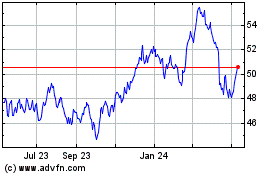TIP SHEET: Schroder Fund Searches World For Value
May 16 2012 - 8:04AM
Dow Jones News
The Schroder International Multi-Cap Value fund (SIDNX) will go
anywhere in the world for a good value.
The fund, rated four stars out of five by Morningstar, has more
than 800 stocks in its portfolio, with investments drawn from all
sectors of the economy and all corners of the globe, except the
U.S. It holds shares in massive companies with market
capitalizations of more than $20 billion and tiny ones worth less
than $250 million. And the managers who run the fund are out
shopping for more investments from a universe of more than 12,000
public companies.
The fund, which has about $20 million in assets under
management, "exploits a universe of enormous breadth," said
Schroder senior client portfolio manager Stephen Kwa. "When we put
the portfolio together, we are not constraining it or making
reference to any benchmark or index."
The fund's two main criteria as it looks for potential
investments are value and quality, and potential investments are
evaluated using screens that examine both. Those factors are the
reason the fund has been underweight on its bank holdings for the
past several years, but is currently overweight on both insurance
companies and asset managers.
Property-casualty companies, life and health insurers and asset
managers constitute 9.6% of the portfolio. Banks, meanwhile, make
up 7.4%.
"Ever since 2007, our team has been very wary of banks," Kwa
said. "We saw the subprime crisis unfolding and initiated new risk
management screens... That's kept us out of the lowest quality
banks."
Insurer holdings include Swiss company Zurich Insurance Group AG
(ZURN.VX); Canada's Manulife Financial Corp. (MFC.T); Australia's
AMP Ltd. (AMP.AU); and the U.K.'s Prudential PLC (PRU.LN) and
Standard Life PLC (SL.LN).
All of them fall into the cheapest 20% in terms of Schroder's
analysis of their valuation, a metric that includes an analysis of
book values, dividend yields and cash-flows. And each is within the
top 20% in terms of quality, Kwa said.
By and large, insurers "haven't experienced the same issues as
banks on their balance sheet," he said. "They tend to score more
highly on quality than banks."
While underweight on banks, the ones that look attractive in
Schroder's analysis include HSBC Holdings PLC (HSBA.LN) and Royal
Bank of Canada (RY.T).
Another important aspect of the fund: holdings aren't weighted
according to their market capitalization, meaning the largest
companies are under-represented relative to global indexes that
might be used as a benchmark for the fund's performance.
Companies classified as mega-cap and large-cap stocks made up
less than half the fund at year-end, compared with 91% of the MSCI
EAFE Index, according to data supplied by Schroder. The MSCI EAFE
Index tracks equity-market performance outside of North
America.
So far, the five-year-old fund has generally outperformed that
index. Year-to-date, the fund is up 3.3%, better than the 2.1% gain
in the index, according to investment site Morningstar.com. The
fund's three-year return is 12.9%, 5 percentage points above the
index. Over five years, the fund is down 2.8%, but that is better
than the 6% decline in the index.
"History has shown us the market leaders have underperformed the
smaller companies," Kwa said.
(Erik Holm covers the insurance industry for Dow Jones
Newswires. He can be reached at 212-416-2892 or by email at
erik.holm@dowjones.com.)
(TALK BACK: We invite readers to send us comments on this or
other financial news topics. Please email us at
TalkbackAmericas@dowjones.com. Readers should include their full
names, work or home addresses and telephone numbers for
verification purposes. We reserve the right to edit and publish
your comments along with your name; we reserve the right not to
publish reader comments.)
Zurich Insurance (QX) (USOTC:ZURVY)
Historical Stock Chart
From Sep 2024 to Oct 2024

Zurich Insurance (QX) (USOTC:ZURVY)
Historical Stock Chart
From Oct 2023 to Oct 2024
